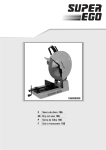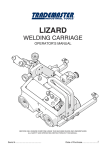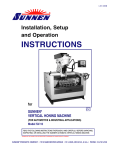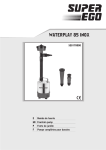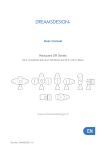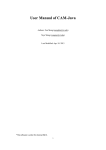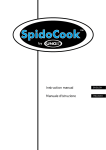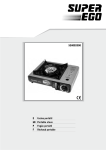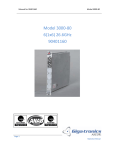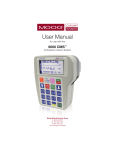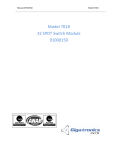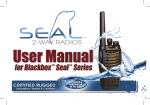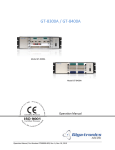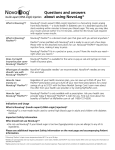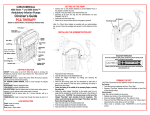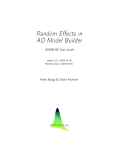Download Volumetric infusion pump AP 31 OPERATING MANUAL
Transcript
Volumetric infusion pump AP 31 OPERATING MANUAL 0197 Model: Serial no.: Operating manual - Volumetric infusion pump AP 31 Dear Customer, thank you for purchasing Ascor S.A. medical equipment. We can assure you this was an excellent choice. Our Company devotes much effort and time to improving its products. If our product fulfills your requirements and expectations, it will be a source of pleasure and satisfaction for our company. Should you have any doubts or remarks regarding the operation or the functionality of the equipment in the course of its exploitation, please do not hesitate to inform us. We will do our best to solve all your problems. We may guarantee that all the remarks will be taken into consideration while designing our new products. President of the Board Ver. 1.2.0 pub. 001 / 05.06.07 Page 2 Operating manual - Volumetric infusion pump AP 31 TABLE OF CONTENTS 1 2 3 4 5 6 7 8 9 10 11 page 3 Read this section carefully! .................................................................... 4 Pump application ....................................................................................... 6 Pump view ................................................................................................. 7 Preparation for operation............................................................................ 14 Pump operation .......................................…...............................................14 5.1 Installation of infusion set...........………........................................... 14 5.2 Switching the pump on and off.........................................................15 5.3 Setting infusion parameters ............................................................ 16 5.3.1 Basic parameters ..................................................................17 5.3.2 Auxiliary parameters.............................................................. 21 5.3.3 Additional parameters........................................................... 22 5.4 Infusion............................................................................................ 26 5.4.1 Information on infusion status............................................... 27 5.5 Alarms, warnings and messages..................................................... 28 5.5.1 Alarms related to power supply............................................. 28 5.5.2 Alarms related to occlusion ................................................. 29 5.5.3 Alarms related to drop detector............................................. 29 5.5.4 Alarm ”AIR” ........................................................................... 30 5.5.5 Alarm ”DOOR” ...................................................................... 30 5.5.6 Alarm ”5 min / end” ............................................................... 31 5.5.7 Alarm ”END OF INFUSION” ................................................. 31 5.5.8 ”Continue ?” query................................................................. 31 5.6 Remarks related to use ................................................................... 31 5.6.1 General remarks.................................................................... 31 5.6.2 Infusion set....................................………............................. 32 5.6.3 Pump powering from an internal battery................................32 5.6.4 BOLUS function ....................................................................32 5.6.5 KVO function ........................................................................ 34 5.6.6 Procedure of NAME entering.................................................34 5.6.7 Pump operation without pre-set volume or time of infusion...36 5.6.8 Change of flow rate without infusion interruption.................. 36 5.6.9 Change of infusion volume without infusion interruption....... 36 5.6.10 Password protection of parameters.......................................36 5.7 Event log...........................................................................................38 Cleaning and disinfection........................................................................... 39 Manufacturer’s responsibility...................................................................... 40 User tests....................................................................................................40 Service and repairs.....................................................................................41 About product and manufacturer ............................................................... 42 Technical data............................................................................................ 44 Ver. 1.2.0 pub. 001 / 05.06.07 Operating manual - Volumetric infusion pump AP 31 1. READ THIS SECTION CAREFULLY !!! Remarks related to user safety. Before commencing pump operation, read carefully this operating manual. • The pump can be operated only by medical staff that has read the user’s manual or has undergone relevant training by authorised personnel of Ascor and holds the required medical qualification for such activities. • Note! For infusion with the use of AP 31 pumps, use only the infusion sets with a silicone segment (length: 220 mm) ASCOSET supplied by Ascor. They guarantee maintenance of high infusion accuracy. • In case of any doubts related to correct pump operation caused by the set, immediately disconnect the set from the patient and remove the set from the pump. An infusion set, which is disposable, should not be used for more than 24 hours. The pump may operate for a short period of time with the drip detector disconnected only during patient’s transport. Note! After turning on the pump, the dosage rate of BOLUS function is set automatically – 1000 ml/h flow rate and 0 ml volume. It is recommended that the pump be connected to the ward call system. Pumps may be suspended only on stands intended for such purpose. No other devices or cloths, such as aprons, can be hung on the pump. No containers with e.g. coffee, tea, etc., can be placed on or nearby the pump. A patient needs to be informed by medical staff that unauthorised tampering with pump keyboard may threaten the patient’s health or life. A pump that has been hit, e.g. in the case of falling down on a hard surface (even if there are no signs of damage) needs to be provided to a hospital service in order to test it for correct operation. In case of any irregularities, provide the pump to an authorised service. Any irregularities in pump operation (for example: “Error 1”, “Error 2” messages) should be immediately notified to the manufacturer together with a detailed description of the even including e.g. conditions of the device operation, environment, external factors, etc. that might have affected the device operation. Caution! Use of pumps in environmental operating conditions not intended by the manufacturer (e.g. device operation in temperatures exceeding the range specified in the manual) may pose a threat to patent’s health or life. Caution! The device may not operate in atmosphere containing inflammable and explosive mixtures of anaesthetic gases or volatile matter explosive vapours. AP 31 pumps contain batteries that ensure device operation without external power supply. If pumps are stored without constant connection to power voltage, the batteries will require periodical charging every two months. Pumps indicate battery discharge during operation. Before providing a pump to the service, disinfect it in accordance with the specified disinfection procedure. Pump service life is estimated at 10 years provided that the recommendations contained in the User’s Manual are observed and regular services (after the guarantee period) are carried out every 12 months It is recommended that the pump be provided to the manufacturer for recycling after its service life. It will ensure appropriate ecological process. It will ensure appropriate ecological process. AP 31 pumps comply with conformity requirements of the European standard EN 60601-224:1998 and the general standard PN-EN 60601-1:1999 regarding basic scope of safety requirements. • • • • • • • • • • • • • • • • • Ver. 1.2.0 pub. 001 / 05.06.07 Page 4 Operating manual - Volumetric infusion pump AP 31 • AP 31 pumps comply with conformity requirements of the electromagnetic compatibility standard (EMC) EN 60601-1-2:1993. Nevertheless, it is recommended that no pump operate close to the devices that do not comply with EMC requirements and do not have the CE marking and, thus, may emit strong electromagnetic radiation. This recommendation also relates to other devices that emit strong electromagnetic field such as X-rays, defibrillators, mobile phones, electrosurgery devices, etc. Description of the most important symbols: - Attention! Read the Operating manual - Class BF device - Separate collection page 5 Ver. 1.2.0 pub. 001 / 05.06.07 Operating manual - Volumetric infusion pump AP 31 2. Pump application Volumetric infusion pumps AP31 are indented for precision dosage of infusion liquids and drugs. They are used, among others, in intensive care units, operating and recovery rooms, paediatric wards, etc. The built-in battery also enables infusion while transporting a patient e.g. between hospital wards or in ambulances. The pumps are characterised by simple operation, reliability and multipurpose use. Note! For infusion with AP 31 pumps, use only the infusion sets with a silicone segment (length: 220 mm) ASCOSET supplied by Ascor. They guarantee maintenance of high infusion accuracy even for long-term infusions. The pump is equipped with an ultrasonic detector of air in the infusion set, protecting the patient against accidental air infusion. The pump can be mounted on a stand, bed frame or stand on a horizontal base nearby the patient. It may operate above and below the level on which the patient is located in any given position (vertical position is not required ). NOTE: • • DO NOT USE THE AP31 PUMP IN PRESENCE OF INFLAMMABLE ANAESTHETICS. DO NOT USE AP31 PUMPS FOR BLOOD AND BLOOD DERIVATIVE TRANSFUSIONS. Ver. 1.2.0 pub. 001 / 05.06.07 Page 6 Operating manual - Volumetric infusion pump AP 31 3. Pump view Fig. 1. Front view. 1. 2. 3. 4. handle, display, keyboard, feet. 1 2 3 4 page 7 Ver. 1.2.0 pub. 001 / 05.06.07 Operating manual - Volumetric infusion pump AP 31 Fig. 2. Side view. 1. 2. 3. 4. 5. handle, door lock lever, clamping unit, door, feet. 2 1 3 4 5 Ver. 1.2.0 pub. 001 / 05.06.07 Page 8 Operating manual - Volumetric infusion pump AP 31 Fig. 3. Back view. 1. 2. 3. 4. 5. 6. 7. 8. handle, clamping unit, handweel, feet, drop detector jack, power socket, RS 232 jack, external 12V power supply socket 5 1 2 3 6 7 8 page 9 4 Ver. 1.2.0 pub. 001 / 05.06.07 Operating manual - Volumetric infusion pump AP 31 Fig. 4. Inside view of a pump prepared for infusion set installation 1. 2. 3. 4. 5. 6. 7. 8. 9. housing with keyboard – pump door, handle, free flow blocking device (when door is open), upper pump beam, air detector, pressure sensor, guide pins, infusion set guide parts, Infusion flow direction. 1 4 3 2 7 6 5 Ver. 1.2.0 pub. 001 / 05.06.07 8 9 Page 10 Operating manual - Volumetric infusion pump AP 31 1 5 6 4 7 8 3 2 Fig. 4a Infusion set installation. 1. 2. 3. 4. upper connector of silicone segment, lower connector of silicone segment, guide parts, guide pins, 5. 6. 7. 8. free flow blocking device, silicone segment pressure sensor air detector Note Observe the following sequence of infusion set installation in the pump. Place the infusion set in such a way that the lower connector of silicone segment (2) is between two quide parts (3). Then place it above air detector (8) and pressure sensor (7) and after moving between two quide pins (4) pull the free flow blocking device right (5) and slide the upper connector of silicone segment (1) above the upper pump beam. Do not stretch the infusion set excessively. page 11 Ver. 1.2.0 pub. 001 / 05.06.07 Operating manual - Volumetric infusion pump AP 31 Fig. 5. Installation of a drop detector on a drip chamber of infusion set. 1. 2. 3. 4. drop detector, drip chamber, rubber O-ring protecting the drop detector against slipping-down. air vent with filter. IMPORTANT REMARKS !!! • • The drop detector should be located above the liquid surface (the liquid level should be up to 1/3 of the drip chamber volume), at about 1/3 length from the top of the drip chamber and rest on a rubber roller (3) (arrange the roller appropriately on the drip chamber). Too high liquid level (above 1/2) in the drip chamber may interfere the drop detector operation and result in the alarm “OCCLUSION / END.” Ver. 1.2.0 pub. 001 / 05.06.07 Page 12 Operating manual - Volumetric infusion pump AP 31 Fig. 6. Keyboard - lamps indicating mains or battery powering, − Flashing lamp indicates infusion in progress − [START/STOP] for starting or stopping infusion − − ON/OFF – used to switch the pump on or off. − to switch the pump off hold 3 seconds − used for priming infusion set and for BOLUS activation − can also be used for NAME entering − lamp signalling proper operation of a drop detector - acoustic alarm mute pushbutton - display backlight − [YES / ENTER / OK] used for confirming displayed information and saving any new entries or modificaions of infusion parameters − [NO / DELETE] resets or rejects the displayed information − [INFO] for information on infusion status , − [programme] starts setting infusion parameters; − il aso enables setting or modification of bolus volume, bolus rate and pressure limit 0-9 page 13 − numeric keys for entering infusion parameters Ver. 1.2.0 pub. 001 / 05.06.07 Operating manual - Volumetric infusion pump AP 31 4. Preparation for operation Preparation of pump operation requires several simple procedures: • mount the pump to a stand, bed frame or put nearby the patient; use the mounting clamp (2) with a wheel (3) (fig.3), • connect the pump to 230V mains using the supplied cable via a pump power supply socket (6) (fig.3) – a green light must be lit near the power symbol (fig.6) • • • • • • • connect the drop detector to a pump socket (5) (fig.3) and temporarily put it on the pump handle (in case of patient’s transport with the pump in operation, we recommend that the detector is disconnected – the pump will then remind about re-connection every 5 minutes). mount the container with the infusion liquid on a hanger above the pump, prepare an ASCOSET infusion set (with a 220 mm silicone segment), filling in the drip chamber up to 1/3 of its volume with liquid, initially remove air from the tubing, block free flow clamp roll in the infusion set and install the infusion set into the pump (fig.4), mount the drop detector on the drip chamber (fig.5), switch the pump on, set infusion parameters and completely remove air from the infusion set using the following pushbutton: insert the needle in patient’s vein and open free flow blocking clamp roll in the infusion set, start infusion using [START]. 5. Pump operation FOR INFUSION USE ONLY “ASCOSET “ INFUSION SETS WITH A SILICONE SEGMENT (length: 220 mm) SUPPLIED BY ASCOR S.A. 5.1 Installation of infusion set ASCOSET infusion set intended for use in the AP31 pump is a specially calibrated set that ensures high dosage accuracy. Prior to placing the ASCOSET infusion set into the pump, prepare it similarly as for a normal drip infusion, i.e. hang the infusion liquid container on the stand, insert (as vertically as possible) the drip chamber into the container, open the air vent, fill in the drip chamber up to 1/3 of its volume with the liquid, remove air from the whole tubing and then block free flow of liquid by a clamp roll. Insert the needle into patient’s vein only after pump programming. Open the pump by pushing a door lock lever (2) (fig.2). Ver. 1.2.0 pub. 001 / 05.06.07 Page 14 Operating manual - Volumetric infusion pump AP 31 Detailed description of the infusion set installation is shown in fig. 4a. Pay particular attention to the direction of liquid flow through the pump. Start placing the infusion set from fastening the lower part of the silicone segment (2) between guide parts (3). Then arrange the infusion set in such a way as to make it go through the guide of air detector (8) and above pressure sensor (7) through guide pins (4). Next, pull away the free flow blocking clamp (5) and place the infusion set into the pass of the upper beam so that the upper part of the silicone segment is over the beam. Release the clamp (5). Do not stretch the infusion set excessively because this may result in errors of pump dosage. Close the pump door (1) (fig.4) and then mount the drop detector on the drip chamber as shown in fig. 5. The detector should be located above the liquid surface, at about 1/3 length from the top of the chamber and rest on a rubber roller (3) (arrange the roller appropriately on the drip chamber). NOTE: • Too low liquid level in the drip chamber (below 1/4 of volume) may result in small bubbles of air appearing during dripping that, when combining in bigger bubbles, often cause the alarm ”AIR” In case of high infusion rates, the infusion set may even get periodically air-locked. • Too high liquid level (above 1/2 of length) may interrupt drop detector operation and result in the alarm “OCCLUSION / END.” • Considerable tilting of the drip chamber caused by incorrect needle insertion in the bottle may result in interruption of drop detector operation and activation of alarms without any cause. • The drop detector is an optic device sensitive to external lighting. • Air-vent closure in the drip chamber may result in material infusion errors and activation of the alarm “OCCLUSION / END.” 5.2 Switching pump on and off The pump is switched on using . The pump is switched off by pressing and holding the same button for (3) three seconds. The pump will memorize the data of the last infusion (among them pre-set volume or time of infusion). In case the pump was switched off before the infusion has been completed, after switching the pump on, the question “Continue ?” will be displayed. If answered with [YES] the infusion can be continued. Pressing [NO] will restart programming of a new infusion. If the infusion is going to be stopped for more than 1 minute it is recommend to switch the pump off. All programmed parameters of the (flow rate, volume or time) will be stored in memory. page 15 Ver. 1.2.0 pub. 001 / 05.06.07 Operating manual - Volumetric infusion pump AP 31 5.3 Setting infusion parameters All infusion parameters are divided into three groups depending on the frequency of use. A simplified outline of individual parameters that enable quick orientation in their localisation is presented below. Infusion pumps AP 31 can be operated in STANDARD of anesthesia (ANESTE) mode. Infusion parameters are set in the same way in both operation modes. STANDARD MODE enables programming of infusion parameters in basic units, such as: rate in ml/h, volume in ml and time in hours/minutes. ANESTE MODE has a drug/dose calculation capability and enables programming of infusion parameters in mass units (e.g flow rate in mg/kg/h) with additional pre-setting of drug concentration (e.g. mg/ml) and patient weight (in kg). The presented below basic parameters relate to pump operation in the standard mode. The way of changing the operation mode is described in chapter 5.3.3, page 23. 1. Basic parameters These are the most important parameters, which enable to set the primary infusion and appearing during programming in the sequence consistent with the list presented below. Their review and programming is possible after switching the pump on, using: These parameters include: • rate (ml/h),volume (ml) or time of infusion (hours, minutes) There may also be • drug name and • time of infusion, • time of pause. The last two are activated with STANDBY function during programming of additional parameters (see chapter 5.3.3, page 23). In case of pump programming in mass units (in ANESTE mode), there is a certain change in set of the basic parameters. The sequence of the parameters will be as follows: • rate (e.g. in mg/kg/h) • drug concentration (e.g. in mg/ml), • patient weight (kg), • total volume (e.g. in mg/kg), • initial dose (e.g. in mg/kg), • bolus volume (e.g. in mg/kg) • drug name and (if STAND-BY function has been activated) • infusion (time of infusion in the Standby mode), • pause (time of interval in the Standby mode) Ver. 1.2.1 pub. 001 / 21.05.07 page 16 Operating manual - Volumetric infusion pump AP 31 2. Auxiliary parameters Presetting, modification or viewing the auxiliary parameters can be done as soon as basic parameters are set, or any time in the running course or during a temporary pause in infusion. It is recommended to set parameters for each infusion, because they are not memorized by the system. After turning on the pump, values of BOLUS flow rate and volume return to basic settings (1000 ml/h flow rate and 0 ml volume). The auxiliary parameters are as follows: • Bolus rate in ml/h, • Bolus volume in ml, • Pressure limit These parameters are programmed in the same way in STANDARD and ANESTE operation modes. 3. Additional parameters Parameters of this group are rarely set. This group of parameters enables user to adjust functions of the device to own needs. Once programmed they will be memorized by the pump. They can be programmed or modified only before starting the infusion set-up. Any modification in running course (without switching the pump off) in not possible. The following additional parameters can be programmed in AP 31 infusion pump: • Password protecting all infusion parameters against unauthorized modification • Operation mode (STANDARD or ANESTE), • KVO - infusion rate in keep-vein-open mode in ml/h, • Alarm – volume and type of sound alarm, • Standby - STAND-BY function on/off, • Ward name, • Drug library - edition or introduction of a new drug name, • Air sensor – level of the air sensor sensitivity These parameters are programmed in the same way in STANDARD and ANESTE operation modes. 5.3.1 Basic parameters After switching the pump on using the following message is displayed: AUTOTEST Ver. 1.2.0 pub. 001 / 05.06.07 Automatic testing of electronic systems, page 17 Operating manual - Volumetric infusion pump AP 31 EN – means English language version EN informing the user of the auto-tests being carried out by the pump. If any irregularities are detected, the pump is automatically stopped and a sound alarm is activated. If such situation appears repeatedly, please contact our maintenance personnel in order to carry out inspection or repair. If no irregularities were found the display will show: Standard – X.X.X SURGERY Operation mode – STANDARD, X.X .X defines the software version installed A ward name will appear in case when it was introduced earlier in additional parameters. In case of AC mains power failure or if the pump is not connected to the mains, the following message will be displayed with an acoustic alarm: “230V AC or 12V DC power supply is absent” NO MAINS If the pump is to be powered from an internal battery, press [YES]. Otherwise the pump should be connected to the mains. Next, two different messages may appear: a) for continuing the interrupted infusion, the following message is displayed: Continue ? “should the previous infusion be continued ?”, This occurs when the pump was switched off before the recent infusion has been completed. Pressing [YES] will enable the recent infusion to be continued according to the previously set parameters and the existing status of the volume counter. Pressing [NO] will mean resetting the volume counter and beginning the setup of a new infusion. b) a message on pump programming method appears: Three methods are available: • • • → Rate and volume, or Rate and time, or Volume and time. Rate and volume Rate and time Select by pressing [NO] and confirm by pressing [YES]. Having selected e. g. Rate and volume, the following message appears on the display: Rate XX.X ml/h “enter the required infusion rate in ml/hour”. Flow rate can be set in 0.1 ml/h increments. The maximum allowable flow rate is 1000 ml/h (the pump will not accept higher values). If the set flow rate is too high, the system displays the maximum acceptable value for the chosen syringe type: Maximum XXX ml/h page 18 “maximum infusion flow rate is XXX ml/h”. Ver. 1.2.0 pub. 001 / 05.06.07 Operating manual - Volumetric infusion pump AP 31 The display will show Rate with the maximum level. The correct data should be entered and confirmed by pressing [YES]. The next parameter will be: Volume xx.x ml “enter the required infusion volume in ml” The field xx.x shows the volume of the last infusion. Pressing [NO] will delete this value and allow entering a new one, which should be confirmed by pressing [YES]. The maximum value of the infusion volume is 9 999 ml. Leaving this parameter out (by pressing [NO] – to delete the previous value and then [YES] to exit without entering any value) or setting it for zero [0] is acceptable, but in such case “END OF INFUSION” alarm will not be activated, and the pump will not stop working until the fluid container is emptied (what will be detected by the drop detector). When Rate and time has been selected, after setting rate of infusion the time of infusion may be entered: Time XX.XX.XX “enter infusion time: hours : minutes : seconds” The maximum infusion time is 100 hours (exactly 99 hours, 59 minutes and 59 seconds). The field XX:XX.XX can show the previously set time value. If it is to be changed, delete it by pressing [NO]. 00:00:00 appears on the display. Enter new numbers from left to right. Blinking zero indicates a position, where a digit can be entered from the numeric pad. The entered digit can be deleted at any time by pressing [NO]. When the correct time value is completed, press [YES] for confirmation. Similarly as in case of volume, this parameter can be left out (with no value entered) or set to zero, which will result in the above described pump performance. The same way of programming should be applied when Volume and time has been selected. In such case, the microprocessor will automatically calculate the infusion rate in ml/h. Next, the following question appears on the display: Show drug? If a drug name is to be displayed during infusion together with the flow rate, answer [YES] and the name of the drug recently used shall appear: Drug name Adrenaline “name of drug recently preset ” If the same drug is to be infused, press [YES]. To change the drug name press [NO]. The following question will appear on the display: Change drug? “change the name of a drug? ” Answer [YES] and information about one of four subsequent drug groups will be displayed: → Group of drugs Ver. 1.2.0 pub. 001 / 05.06.07 page 19 Operating manual - Volumetric infusion pump AP 31 Group A-L You can change groups by pressing [NO] and confirm with [YES] to enter the group and select a specific drug name. First two drug groups (Group A-L and Group L-Z) include drugs entered by the manufacturer in alphabetical order, whereas the next two (User 1 and User 2) include drugs of the user (for information on how to enter the drug names, see chapter 5.6.6, page 35). Selection of drug names can be done by pressing [NO]. Confirm the selected drug name by pressing [YES]. If the pump is to be used in a STAND-BY mode, two additional parameters (time of infusion and time of pause), should be set. Another step is the information about correct pump programming and simultaneously about installation of the infusion set: Prime << Check whether the infusion set contains air. If necessary prime the tubing by pressing [<<] to remove air bubbles. Stop priming by pressing [YES]. The next message means that the pump is ready for operation. Infusion no. 158 Press START Before commencement of infusion, it is often necessary to view such parameters as bolus rate, bolus volume and occlusion pressure limit. This can be done using • Sometimes other messages appear instead of “Prime <<”. In case door is open, this will be !!! DOOR !!! Close the pump door appropriately. • If the installed infusion set contains air, a message appears: !!! AIR !!! Then it is necessary to prime the infusion set by pressing and holding page 20 Ver. 1.2.0 pub. 001 / 05.06.07 Operating manual - Volumetric infusion pump AP 31 During air removal, always disconnect the infusion set from the patient !!! • Failure to connect the drop detector, its impurity or incorrect placement on the drip chamber results in the following message: DROP DETECTOR If the detector is intentionally disconnected (e.g. during patient’s transport with the pump) silence the alarm and press [START]. Press [START] or [YES] to start the infusion. Before commencement of infusion, it is often necessary to view such parameters as infusion rate, bolus . 5.3.2 Auxiliary parameters Presetting, modification or viewing the auxiliary parameters can be done as soon as basic parameters are set, or any time in the running course or during a temporary pause in infusion. There is need to set parameters for each infusion, because they are not memorized (except the occlusion pressure) by the system. Subsequent infusion will be carried out according to the factory settings. BOLUS setting Access to the described parameters is possible by pressing [F]: The first parameter is: Bolus rate XXX ml/h Bolus rate in ml/h where XXX defines the last Bolus rate programmed. After turning on the pump, values of BOLUS flow rate and volume return to basic settings (1500 ml/h flow rate and 0 ml volume). Enter the required Bolus rate and confirm it by pressing [YES]. The maximum Bolus rate is 1500 ml/h. In case of leaving this parameter blank, the pump will deliver a bolus dose at a maximum infusion flow rate. Attention! • The pump will not accept a Bolus rate lower than the preset doubled infusion flow rate. For example, when the infusion flow rate amounts to 25 ml/h, the minimum bolus rate will be 50 ml/h. The next parameter will appear on the display: Ver. 1.2.0 pub. 001 / 05.06.07 page 21 Operating manual - Volumetric infusion pump AP 31 Bolus volume XX.X ml Bolus volume in ml Enter the required value and confirm it by pressing [YES]. If the Bolus volume is not preset, the infusion in BOLUS mode will be continued as long as BOLUS pushbutton is pressed. When infusing Bolus, it’s volume delivered will be displayed in ml. The volume of the drug administered in BOLUS mode will be summed up with the total volume of the drug administered to the patient during the basic infusion. Infusing Bolus can be started by pressing and stopped by pressing Startup of the BOLUS function is described in more details in Chapter 5.6.4., page 33. Setting the limit level of infusion pressure. The next parameter that will be shown is the pressure level, at which ”OCCLUSION” alarm should be activated. Pressure Limit 45 kPa It is possible to enter any value from 40 to 80 kPa (300 mmHg to 600 mmHg). Confirm by pressing [YES]. 5.3.3 Additional parameters This group of parameters enables the user to adjust possibilities of the pump to his own needs. The setting procedure should start when the pump is switched off. To enter the additional parameters, proceed as follows: press the pushbutton: and, while keeping it pressed switch the pump on. The following message will be displayed: Menu page 22 Ver. 1.2.0 pub. 001 / 05.06.07 Operating manual - Volumetric infusion pump AP 31 Automatic access to the following options is available: “Settings” – setting of additional parameters “Service” - reserved for authorized service only “Tests” - user tests, see Chapter 8, page 41 “Event log” - saved infusion history, see Chapter 5.7, page 39 “Setup exit” - allows EXIT from Menu “Production” - reserved for manufacturer’s production staff only. Selection of Menu options can be done by pressing [NO]. Select Settings to programme additional parameters of infusion: →Settings Service and enter by pressing [YES]. The first parameter which appears on the display is: →Change password Operation mode “Change password” option enables entering a new one or modifying the previous password to protect all infusion parameters against any unauthorized modification. Press [NO] if you do not want to enter a password or modify the previous one. Press [YES] to enter: →PASSWORD Entering a number (other than zero) in the range between 1 and 999999 and confirming it by pressing [YES] will mean that the infusion parameters will be protected with a password. In such case, before any modification of infusion parameters, the following message will be displayed: “PASSWORD”. To get access to modification of infusion parameters, the correct password must be entered from the keyboard and confirmed by pressing [YES]. Attention! If you forgot the password – read Chapter 5.6.1. (page 32) If you entered Change password option and do not want to enter a new one or change the previous password, enter [0] and confirm by pressing [YES]. The next parameter is the “Operation mode” of the pump: →Operation mode KVO Press [YES] to enter and than select by pressing [NO] the operation mode: STANDARD or ANESTE. Confirm it by pressing [YES]. STANDARD mode is a typical one and allows simple way of programming infusion rate in ml/hour. Ver. 1.2.0 pub. 001 / 05.06.07 page 23 Operating manual - Volumetric infusion pump AP 31 ANESTE mode has a drug/dose calculation capability and allows programming infusion rate in mass units, e. g. mg/kg/h with regard to the patient weight. From this data and the drug concentration, the pump will automatically calculate the rate in ml/h. Setting a particular operation mode of the pump means that the pump shall be ready for operation in this particular mode, right after the pump start-up. The next parameter is the infusion flow rate in the KVO mode: KVO X.X ml/h KVO (Keep Vein Open) function means that instead of complete infusion stopping, e.g after pressing [STOP] pushbutton, a minimum flow rate is maintained in order to keep the needle patency (avoiding clotting). A typical flow rate of such infusion is 0.5 ml/h, and this value is pre-set by a manufacturer. It is possible to set another KVO rate within the range 0 - 5.0 ml/h. Leaving this parameter out (without any value entered) means setting it for 0,5 ml/h. Volume of the fluid received by the patient during the activated KVO function adds up to the total quantity of drug received by the patient. NOTE! KVO rate cannot be higher than the basic infusion flow rate. The next parameter is: → Alarm Standby There are two settings of this parameter: type and volume. → Alarm type Alarm volume Press [YES] to chose the type of alarm. The acoustic alarm sound can be continuous (______) or intermittent (- - - - ). → Alarm type --------------Choose the required one by pressing [NO] and confirm it by pressing [YES]. The next parameter is Alarm volume: → Alarm volume Alarm vol. 2 Enter this option by pressing [YES], and select the required alarm volume by pressing [NO]. You can select: Confirm Alarm vol. 0 - low volume (quiet) Alarm vol. 1 - medium volume Alarm vol. 2 - high volume (loud) the required alarm volume by pressing [YES] and exit by pressing [F]. Subsequently, you go to the next parameter” “Standby”. → Standby Ward name This function is used very rarely and allows to cyclically stop the infusion. Selecting “Standby on” will result in adding two additional parameters to the basic group of parameters: the time of infusion page 24 Ver. 1.2.0 pub. 001 / 05.06.07 Operating manual - Volumetric infusion pump AP 31 (infusion) and the time of pause (pause). This cycle will be continued untill the end of infusion. At the moment when the programmed time has elapsed, there will be and acoustic alarm STANDBY OFF, after which the alarm should be muted and the pump’s operation stopped with STOP. After the programmed time of pause has elapsed, there will be another alarm STANDBY ON. After having muted the alarm, the infusion should be started with START. The next parameter is “Ward name”: → Ward name Drug library Press [NO] to switch over to Drug library or press [YES] to enter. Here, the name of the hospital ward may be entered. It can be entered in accordance with “Procedure of NAME entering”, described in details in Chapter 5.6.6, page 35. The next parameter allows entering the name of the administered drug, which will be displayed during infusion, together with the infusion flow rate. → Drug library Change password One out of four drug groups can be selected by pressing [NO] and confirmed with YES. All drugs previously entered into the library can be viewed, cancelled and modified here. → Group of drugs Group A-L The first two groups (Group A-L and Group L-Z) include drugs in alphabetical order entered by the manufacturer, while the next two (User 1 and User 2) enable creating the user’s drug list with the drugs most frequently used in the ward. Detailed information on how to enter drug names, see “Procedure of NAME entering”, Chapter 5.6.6, page 35. To exit Drug Library press: The next parameter is the Air sensor sensitivity. → Air sensor Change password Entering this parameter is by pressing [YES]. There are three levels of the Air sensor sensitivity: - High level – all of the air bubbles are detected - Medium level – 7 mm and longer bubble is detected - Low level – 10 mm and longer bubble is detected Choosing between this levels is by pressing [NO] and accepting is by pressing [YES] Ver. 1.2.0 pub. 001 / 05.06.07 page 25 Operating manual - Volumetric infusion pump AP 31 5.4 Infusion After the infusion programming procedure has been completed and the infusion set connected to patient’s needle, infusion can be commenced. The following message is then displayed: Infusion no. 158 Press START Check whether the plastic free flow blocking roller clamp located on the infusion set has been unblocked! Infusion is activated after pressing: Infusion in progress is signalled by a flashing green light [START/STOP] and the following message: Rate X.X ml/h or in case of programmed drug name e.g.: NaCl X.X ml/h where X.X determines the rate of infusion. During infusion, it is possible to monitor the infusion status. This can be done very easily by pressing [INFO] repeatedly. The following information will be available one by one: pre-set volume, volume already infused, remaining volume, time left till the end of infusion, pressure in line, battery status. After a few seconds the pump will return to displaying the infusion rate. Information about infusion can be viewed many times in running course with no need for infusion interruption. There is also a possibility to change the infusion rate in running course. To do that, enter a new value from the numerical keyboard and confirm using [YES]. Then, the pump will start operating with a new rate of infusion. The pump enables temporary stoppage of infusion without cutting off the power supply. To do that, press [START/STOP]; the flashing lamp changes its colour from green to red and a message appears: STOP X.X ml/h KVO X.X ml/h where X.X is the rate of infusion. The pump automatically switched over to KVO mode. After a minute there will be an acoustic alarm. If the infusion is to be stopped for more than 1 minute, it is recommended to switch the pump off. After re-switching it on, the infusion can be continued with all data of the interrupted infusion saved. page 26 Ver. 1.2.0 pub. 001 / 05.06.07 Operating manual - Volumetric infusion pump AP 31 If the volume or time of infusion has been programmed, an alarm is activated five minutes before the end of dosing. After pressing the alarm cancelling button: (silence), the following message appears: 5 min. / end It disappears automatically after pressing the alarm cancelling button. End of infusion is indicated by a sound and a message: END OF INFUSION This alarm appears only if the volume or time of infusion has been programmed. Then KVO infusion is automatically activated. KVO function ( KEEP VEIN OPEN) ensures that, despite termination or discontinuation of infusion, the patient still receives a small dose of liquid to prevent clots in the needle. Rate of this infusion is very small, usually 0.5ml/h. At any moment during infusion without its interruption, it is possible to view and modify auxiliary parameters such as Bolus volume and rate, and occlusion pressure level. To do this, press [F] and brows displayed values using [YES]. Press [NO] to modify, enter a new value and confirm by pressing [YES].. NOTE: If the pump is switched off using , no information about infusion (about the set volume and time of infusion) is lost only provided that the infusion is continued after reactivation of the pump. The question “Continue?” is answered with [YES]. 5.4.1 Information on infusion status At any moment during infusion, there is a possibility of checking it’s status. This can be easily done by pressing [INFO] button repeatedly. The following information will be displayed one by one: → Volume XX.X ml → Volume infused XX.X ml → Remaining volume X.X ml → Time/end XX:XX:XX Ver. 1.2.0 pub. 001 / 05.06.07 XX.X – total volume to be infused in ml XX.X – volume in ml, already infused XX.X – remaining volume in ml, to be infused XX:XX:XX – time left to complete the infusion – hour:min:sec page 27 Operating manual - Volumetric infusion pump AP 31 Pressure ■■■■■■□□□□□□□□ current pressure level Battery ■■■■■■■■■■■■□□ current battery status Air 0 ml accumulated volume of air Press [NO] in order to return to infusion rate display. The information on the infusion status can be checked as often as it is required and will not affect the infusion process. After each step you can exit INFO option and return to the infusion rate display by pressing [F]. 5.5 Alarms, warnings and messages All situations requiring the medical staff intervention are signalled with an acoustic alarm, red – flashing lamp, display blinking and messages clearly displayed. To mute the acoustic signal press: (silence). 5.5.1 Alarms related to power supply Alarm: NO MAINS informs the staff that there is a failure of mains supply. After muting the alarm, the pump automatically switches over to the battery powering. This may be a result of the mains failure, fuse blow-out or disconnection of the power cable. The pump continues infusion. Message: LOW BATTERY Means that the battery will be completely discharged after ca. 30 minutes of infusion with 1000 ml/h (for 25 ml/h ca. 90 minutes). Connect the pump to the mains as soon as possible. The pump continues infusion. page 28 Ver. 1.2.0 pub. 001 / 05.06.07 Operating manual - Volumetric infusion pump AP 31 5.5.2 Allarms related to occlusion Alarm: OCCLUSION informs the staff that the allowable pumping pressure has been exceeded as a result of: • accidental clamping of the infusion set, • clot in the needle or perforation of the vein wall by the needle, • the alarm may also appear if a closed air-vent is left in the drip chamber. • too high liquid level (above ½ volume) in a drip chamber may also interfere the drop detector operation and result in OCCLUSION/END alarm THE PUMP OPERATION IS DISCONTINUED. Some time passes from the occlusion to pump stoppage. It depends on the set rate of infusion, and the infusion set flexibility and length. The lower the rate of infusion, the longer the pump response time to the occlusion. Occlusion of the infusion set can be checked by activation of infusion and observation of dripping, or by opening the pump door and temporary activation of the free flow of the liquid (after removing the blocking clamp (3) (fig.4)). The last method can be used only if the pump infuses liquids with low drug concentration and in large volume; a dosage error in this case will be insignificant. “OCCLUSION” alarm may also result from problems with the drip detector when: • liquid level in the drip chamber is too high, exceeds 1/2 o drip chamber length, • the drip detector is too close to liquid surface in the drip chamber; should be mounted at 1/3 of drip chamber length from the top and be secured against sliding down with a rubber ring, • the drip detector is excessively lit. After removing the cause of occlusion, the pump can continue dosage without any loss of information about the determined liquid volume and time of infusion or time until the end of infusion. 5.5.3 Alarms related to drop detector Message: DROP DETECTOR signalises the problem with a drop detector resulting from its disconnection, incorrect placement on the drip chamber (it should be above the liquid surface), damage or intensive impurity. See also chapter 5.5.2. and 5.1. PUMP OPERATION IS DISCONTINUED. After removing the cause of alarm, the pump may continue dosage without any loss of information about the determined liquid volume and time of infusion or time until the end of infusion. Ver. 1.2.0 pub. 001 / 05.06.07 page 29 Operating manual - Volumetric infusion pump AP 31 If the detector has been intentionally disconnected (e.g. during patient’s transport between the hospital wards), silence the alarm and press [START] to continue infusion This way the pump will remind about operation with drop detector disconnected every 5 minutes. 5.5.4 “AIR” alarm Message: !!! AIR !!! informs that air appeared in the infusion set. The ultrasound detector mounted in the pump detects at the three levels of the sensitivity (look at the additional parameters on the page 25).The reasons for air bubble appearance in the line may also be use of air-locked (rough) liquid or its violent cooling down or warming up. Moreover, too low liquid level in the drip chamber (should be within the limits from 1/4 to 1/3 of chamber length), incorrect infusion set priming with the liquid (air left), mechanical damage of (*) the infusion set, intense impurity of the air detector (5) (rys.4) or wrong installation of the infusion set in the pump may also contribute to activation of the alarm. (see also chapter 5.1 on page 14). PUMP OPERATION IS DISCONTINUED. After removing the cause of alarm, the pump can continue dosage without any loss of information about the determined liquid volume and time of infusion or time until the end of infusion. (*) air detector guide (5) (fig. 4) 4) should be clean, without any trace of liquid overflow !!! 5.5.5 “DOOR” alarm Message: !!! DOOR !!! notifies the staff about opened pump door or that is has opened during infusion (without pump stoppage). PUMP OPERATION IS DISCONTINUED. Close the door! The pump can continue dosage without any loss of information about the determined liquid volume and time of infusion or time until the end of infusion. 5.5.6 ”5 min. / end” alarm Message: 5 min / end informs about approaching to the end of infusion. The alarm appears only if the volume or time of infusion has been programmed. The pump continues operation. page 30 Ver. 1.2.0 pub. 001 / 05.06.07 Operating manual - Volumetric infusion pump AP 31 5.5.7 “END INFUSION” alarm Message: END OF INFUSION signalises that the programmed liquid volume has already been infused to the patient or the pre-set time of infusion has expired. The alarm appears only if the volume or time of infusion has been programmed !!! Then KVO function, including display of information about the rate of infusion, is automatically activated. KVO function ( KEEP VEIN OPEN) ensures that, despite conclusion or discontinuation of infusion, the patient still receives a small dose of liquid to prevent clots in the needle. Rate of KVO infusion can be from 0 to 5 ml/h. 5.5.8 ”Continue ?” query Continue ? The query appears if infusion is interrupted by switching the pump off. The pump retains all the infusion parameters and, after reactivation, it is possible to continue operation with previously set parameters. All you need to do is to answer [YES]. Press [NO] to programme a new infusion. The message about the programming method, which is characteristic for commencement of every new infusion will be displayed: →Rate and volume Rate and time From this moment, programming of infusion parameters is carried out from the beginning. 5.6 Remarks related to use 5.6.1 General remarks • • • • • DO NOT USE THE AP31 PUMP IN PRESENCE OF INFLAMMABLE ANAESTHETICS. DO NOT USE AP31 PUMPS FOR BLOOD AND BLOOD DERIVATIVES TRANSFUSION. Connection of the pumps to the mains is signalled by a green lamp. It is recommended that the pump is left connected to the mains also after operation to continue battery charging (may be left connected to the mains for any time). This guarantees full battery charging. Battery power supply is recommenced only in necessary cases, e.g. no power supply patient’s transport. Time required for full battery charging from the moment of complete discharge is ca. 36 hours. During battery charging, the pump operates as usual. If there is voltage in the mains socket and the pump signals “NO MAINS”, it may mean: Ver. 1.2.0 pub. 001 / 05.06.07 page 31 Operating manual - Volumetric infusion pump AP 31 a burnt fuse: replace using a fuse attached to the Manual or another with parameters consistent with the technical data contained in chapter 11, page 44, o a damage of the power cable: connect another one, o a pump damage that requires intervention of the service. Fuses are located in the connection socket nearby the pump power cable. To replace fuses, disconnect the power cable, turn stoppers e.g. using a screwdriver and replace fuses with identical ones. If fuses burn again, contact the service. Repairs of damaged pump can be done only by the factory service or another authorised by a certificate to repair Ascor devices. Any unauthorised repairs may result in pump malfunction and pose a threat to the patient. Each use of the pump should be thoroughly considered and the responsibility for its use is borne by the operator (e.g. a doctor or a nurse) who should take into account the technical capacity of the device declared by the manufacturer and pharmacokinetics of the infusion. o • • • • If it is not possible to restore the protection password, enter the code 550.555 to unlock. 5.6.2 Infusion set • WITH AP 31 PUMP USE ONLY ASCOSET INFUSION SETS SUPPLIED BY ASCOR S.A. THESE ARE THE ONLY INFUSION SETS WHICH GUARANTEE A SAFE OPERATION OF A PUMP AND THE HIGHEST ACCURACY OF DOSING. • Do not use infusion sets for more than 24 hours. In case of long infusions (large volume), dosage accuracy deteriorates because of the infusion set deformation. Too low liquid level in the drip chamber (below 1/4 of volume) may result in small bubbles of air appearing during dripping that, when combining in bigger bubbles, often cause ” !!! AIR !!!” alarm. In case of high infusion rates, the infusion set may even get periodically air-locked. Too high liquid level (above 1/2 of length) may interrupt drop detector operation and result in the alarm “OCCLUSION.” Closure of the air-vent in the drip chamber may cause errors of infusion and appearance of “OCCLUSION” alarm. • • • 5.6.3 Pump operation from an external battery Operation time of the pump powered from an internal battery depends on the rate of infusion and amounts to: • min. 20 hours in case of rate of 5 ml/h • min. 3 hours in case of rate of 1000 ml/h NOTE: The aforementioned data relate to completely charged battery. Charging time is: 24 hours to 80%, 36 hours to 100% of volume. Charging is activated automatically when the pump is connected to the mains (a yellow lamp near the battery symbol is lit). Pump operation does not affect the time of battery charging. The specified times concern a new battery. 5.6.4 “BOLUS” function • A new volumetric infusion pump contains factory settings that also include the so-called standard bolus. This is a shock dose that can be infused at any time during infusion. Standard bolus rate is 1000 ml/h. For more information about the bolus rate and volume look at the Auxiliary parameters (page 21) page 32 Ver. 1.2.0 pub. 001 / 05.06.07 Operating manual - Volumetric infusion pump AP 31 Bolus can be infused without any programming and thus it’s volume will depend on how long BOLUS button is pressed, and it’s rate will be a doubles rate of the basic infusion. The described “manually” activated bolus is initiated by pressing: For safety reasons bolus is activated after 3 seconds of holding BOLUS button. Certainly, it is possible to programme or modify the Bolus rate and the Bolus volume. It can be done during: 1 - programming of infusion parameters, or 2 – in running course of infusion In the first case it can be done after the basic parameters of infusion are pre-set and the message displayed: Infusion no. 158 Press START Before pressing START to commence infusion, you can press: to enter: Bolus rate 1000 ml/h Bolus rate in ml/h where 1000 defines default Bolus rate. Enter by pressing [YES], delete the previous value by pressing [NO], introduce the required Bolus rate and confirm it by pressing [YES]. The maximum Bolus rate is 1500 ml/h. Attention! • The pump will not accept a Bolus rate lower than the preset doubled infusion flow rate. The next parameter will appear on the display: Bolus volume XX.X ml Bolus volume in ml Enter by pressing [YES], delete the previous value by pressing [NO], introduce the required Bolus volume and confirm it by pressing [YES]. The maximum Bolus volume is limited to the pre-set volume of infusion. The pump will not accept a higher value. EXIT by pressing [F]. Bolus function can be activated by pressing for 3 seconds Ver. 1.2.0 pub. 001 / 05.06.07 page 33 Operating manual - Volumetric infusion pump AP 31 and stopped by pressing If the Bolus volume has been preset, after its activation the BOLUS button need not to be hold. The pump will automatically administer the pre-set volume. Even if the Bolus volume has been preset, it can be stopped at any moment by pressing [STOP]. If the Bolus volume has not been programmed, it will be infused as long as BOLUS button is pressed. When infusing Bolus, it’s volume delivered will be displayed in ml. The volume of the drug administered in BOLUS mode will be summed up with the total volume of the drug administered to the patient during 5.6.5 KVO function KVO function ( KEEP VEIN OPEN) ensures that, despite conclusion or discontinuation of infusion, the patient still receives a small dose of liquid to prevent clots in the needle. Rate of this infusion is minimum and should not affect the primary drug infusion by its volume. Factory set value of KVO is 0.5 ml/h. It can be changed by entering Menu and Settings as described in chapter 5.3.3 on page 23 (Additional parameters). 5.6.6 Procedure of NAME introduction Not only numerical but also alphabetical data can be entered into the pump. Hospital ward name can be entered before setting the pump, the drug library can also be modified by entering new items. It is necessary to become acquainted with the method of character entering. The names are entered during the navigation through the pump Menu. Two parameters Ward name and Drug library can be reached in the Settings set. • Ward name After entering Ward name (by pressing [YES]), the following information will appear on the display: Ward name _ “empty” name without entry or previously entered: Ward name ONCOLOGY_ page 34 Ver. 1.2.0 pub. 001 / 05.06.07 Operating manual - Volumetric infusion pump AP 31 In the first case, it is possible to enter directly a new name, in the second case, the previous name should be deleted by pressing [NO] to delete each character separately and only then a new drug name can be entered. Horizontal cursor indicates the edition spot of a new character. The characters should be entered with the following pushbuttons. Pressing [<<] generates subsequent figures from 9 to 1 and alphabet characters from Z to A and after each successive pressing the next character appears in the position indicated by cursor. By pressing [START/STOP] alphabet characters appear in a reverse sequence. Each separate character entered must be confirmed by pressing [YES]. The cursor moves on the position of the successive character, which you can enter in the same way. To save the entered name press [YES] for 3 seconds. • Drug name To change the drug name or to enter its new name the procedure described above should be followed. You can view drugs which have been saved by selecting with [YES] the Drug library. Drugs are grouped in four catalogues. Two of them contain drugs saved by the manufacturer (Group A-L and Group L-Z) and the two other consist in drug names entered by the user (User 1 and User 2). Each catalogue contains 16 names, which means that there are 64 drugs at the disposal of a user. To change or enter the drug into the user catalogue, select: Group of drugs →User 1 Select group by pressing [NO] and enter the chosen one by pressing [YES]. Then the information on the individual drugs appears on the display: Drug name →1 To start the name entering procedure press [YES]. The cursor will indicate the character to be edited (it can be moved left by pressing [NO]), for example: Drug name →1 or “empty” name i.e. also with the cursor Changing the name and entering a new one is done according to the description above. To delete the previous position, press [NO] for each letter to be deleted. With [<<] or [START/STOP] you can choose the correct alphabetical order, select a character to be entered and accept it with [YES], automatically moving the cursor to another position. Each separate character entered must be confirmed with [YES] . To save the entered name in the pump memory hold [YES] for 3 seconds. Press [F] to exit and select in Menu Setup exit. Ver. 1.2.0 pub. 001 / 05.06.07 page 35 Operating manual - Volumetric infusion pump AP 31 5.6.7 Pump operation without pre-set volume or time of infusion The AP31 pump can operate without programmed infusion volume. In this case, dosage is interrupted when infusion liquid container is emptied. Volume infused to the patient and time of infusion can be read using [INFO]. After reactivation of infusion (if the pump has not been switched off using [OFF]), the pump counts the volume and time of dosing taking into account previous infusion. Volume and time meter is deleted after pump deactivation. Capacity of the volume meter is 10 l (in fact 9999 ml) and time meter - 100 hours (in fact 99 hours 59 minutes 59 seconds). NOTE! If neither time nor infusion has been programmed END OF INFUSION alarm will be not activated. 5.6.8 Change of flow rate without infusion interruption During the pump operation, in running course, there is a possibility to change the flow rate with no need for infusion interruption. It can be done very quickly and easily by entering a new value from the numerical keyboard and confirming it by pressing [YES]. From this moment the pump will infuse with a new rate. Volume and time meters of pump operation are not deleted. 5.6.9 Change of infusion volume without infusion interruption During the pump operation, it is possible to modify the volume of infusion pre-set. To do this press [INFO] button and at the moment when “Volume XX ml” is displayed enter a new value from the numerical keyboard and confirm it by pressing [YES]. If the entered value is lower than the meter readout (volume already infused), the relevant information will be displayed. Volume and time meters of pump operation are not deleted. 5.6.10 Password protection of parameters Password protection is used in two parameter groups. One group includes parameters set by the user, who can modify already existing and factory pre-set parameters. Then the password protection will prevent the settings against any unauthorized modifications. Another case are: Service and Production catalogues, in which data are available to authorized service or manufacturer’s production staff only. The description of password protection of infusion parameters, that are available to all users is presented below. When the pump is switched off press page 36 Ver. 1.2.0 pub. 001 / 05.06.07 Operating manual - Volumetric infusion pump AP 31 and while holding it pressed switch the pump on. The following message will be displayed: Menu And after a while an access to the following catalogue will be available: →Settings Service Enter it by pressing [YES] . The first parameter which appears on the display is: →Change password Operation mode “Change password” option enables entering a new one or modifying the previous password to protect all infusion parameters against any unauthorized modification. Press [YES] to enter: →PASSWORD Entering a number (other than zero) in the range between 1 and 999999 and confirming it by pressing [YES] will mean that the infusion parameters will be protected with a password. In such case, before any modification of infusion parameters, the following message will be displayed: “PASSWORD”. To get access to modification of infusion parameters, the correct password must be entered from the keyboard and confirmed by pressing [YES]. Attention! If you forgot the password – read Chapter 5.6.1 (page 32) to learn how to unblock the system. If the password protection is not to be used, enter [0] and confirm by pressing [YES]. or just during further navigation through Menu catalogues press [NO] when “Change password” is displayed and thus switch over to the next catalogue. Ver. 1.2.0 pub. 001 / 05.06.07 page 37 Operating manual - Volumetric infusion pump AP 31 5.7 Event log Event log in AP 31 pump allows to retrace ca 500 events of the previous infusions. These are dates, hours, parameters and other information on the performed infusions. When the pump is switched off press and while holding it pressed switch the pump on. The following information will appear on the display: Menu And after a while: →Settings Service Select Event log by pressing [NO] and enter it by pressing [YES]. The number and date of the last infusion will appear on the display, for example: Infusion No. 10 2005.03.22 After pressing [NO], information on the earlier infusions is accessible, e.g.: Infusion No. 9 2005.03.21 After having selected the infusion number and date, enter it by pressing [YES], the following information will be displayed: Rate 6 ml/h Volume 20 ml Rate of infusion Preset volume of infusion The next information on the display is the following question: Parameters? Other infusion parameters? By pressing [YES] pushbutton again, you will see in turn other pre-set infusion parameters: KVO 0.5 ml/h Bolus rate 1200 ml/h Bolus volume 10 ml page 38 Ver. 1.2.0 pub. 001 / 05.06.07 Operating manual - Volumetric infusion pump AP 31 10 ml Pressure limit 80 kPa The next information is: Events? Infusion events review? Press [YES] to see the events connected with the infusion e. g.: START 6 ml/h XX:XX:XX Infusion start hour Inf. 6 ml/h XX:XX:XX Rate 10 ml/h XX:XX:XX Infusion rate after the start time Change of infusion rate during the infusion time of change BOLUS 1200 ml/h XX:XX:XX Bolus administration during the infusion time of starting bolus infusion Inf. 6 ml/h XX:XX:XX Return to the basic infusion time 5 min/end XX:XX:XX Alarm “5 min left till the infusion end” time of alarm activation STOP XX:XX:XX Temporary stop of the infusion (pause) time 6. Cleaning and disinfection Before starting the cleaning procedure, the pump should be switched off with pushbutton and the supply cable should be disconnected (plug removed from the socket). Cleaning can be carried out with a cloth and a water solution of detergent (e.g. for cleaning dishes) or others, based on isopropyl alcohol. After cleaning, the pump should be dried before connecting it back to the mains and starting it’s operation. Ver. 1.2.0 pub. 001 / 05.06.07 page 39 Operating manual - Volumetric infusion pump AP 31 7. Manufacturer’s responsibilities Manufacturer is responsible for safety, both for the patient and the user, and correct operation of the device, according to the technical data detailed in this operating, provided that: • the equipment is operated in accordance with its application and in ambient conditions suitable for this type of equipment. • installation of the equipment in the working environment is performed in accordance with the requirements included in this operating manual, • the device is operated in accordance with this operating manual by a trained medical personnel, • inspections, repairs and modifications were only made by an authorized service company. The manufacturer recommends carrying out the technical inspection before the expiry of guarantee period. After the expiry of guarantee period, systematic review of the equipment should be conducted every 2 years by an authorized service only. 8. User Tests AP 31 pumps are equipped with a set of tests to check the correct operation of its main subassemblies. These tests can be helpful in evaluating the condition of the pump, but they do not guarantee detection of all existing faults, if any. In case of any doubts regarding the condition of the equipment or accuracy of it’s operation, the pump should be immediately delivered to the hospital maintenance department in order to check it and/or take further steps, e.g. repair by an authorized servicing company. To start User Tests the pump should be connected to the 230 V powers supply. When the pump is switched off press and without releasing it switch the pump on. The following information will appear on the display: Menu and within a moment: →Settings Service Select Tests by pressing [NO] and enter it by pressing [YES]. →Tests Event log This will activate the user test module. The first test will be displayed. To carry out the test, enter it by pressing [YES]. Otherwise press [NO] to select the right test and enter it by pressing [YES]. 1 Display test page 40 Ver. 1.2.0 pub. 001 / 05.06.07 Operating manual - Volumetric infusion pump AP 31 →Display The test allows to state whether the display is fully active. To exit press [F]. 2 Keyboard Test →Keyboard Pressing subsequent pushbuttons allows to check whether all pushbuttons are active. To exit press [F] for a few seconds. 3 Battery Test →Battery The battery condition is displayed here. In order to receive exact information, the power supply should be disconnected (power switch off). If the battery voltage is below 9 V or it will diminish continuously – the battery should be replaced with a new one. Press [F] to exit. 4 Operating Time Test →Operating time The parameter informs on the number of hours the pump has been operating. Press [F] to exit a separate test and once again [F] to exit Tests catalogue. 9. Service and repairs All servicing issues should be notified directly to the manufacturer or the local equipment distributor. Any repairs of the pumps can be carried out only by manufacturer or a trained servicing company authorized by the manufacturer. Manufacturer will secure after-guarantee servicing of AP 31 pump. For any information concerning service, please contact ASCOR S.A. e-mail: [email protected] or the local distributor of ASCOR equipment. ASCOR S.A. does not take any responsibility for any unauthorized servicing of AP 31 pump. Ver. 1.2.0 pub. 001 / 05.06.07 page 41 Operating manual - Volumetric infusion pump AP 31 10. About product and manufacturer AP 31 pumps have been produced by ASCOR S.A. Company which introduced and maintains the Quality Management System, complying with the international and the European standards, approved by ISO 13485:2003 and ISO 9001:2000 certificates. The above certificates have been issued by a German notified body TÜV Rheinland Product Safety GmbH – Am Grauen Stein – D-51105 (not. No. 0197). 4. Guidance and manufacturer’s declaration – electromagnetic emissions The AP 31 is intended for use in the electromagnetic environment specified below. The customer or the user of the AP 31 should assure that it is used in such an environment. Emissions test Compliance Electromagnetic environment guidance RF emissions Group 1 The AP 31 uses energy only for its CISPR 11 internal function. Therefore, its RF emissions are very low and are not likely to cause any interference in nearby electronic equipment. RF emissions Class B CISPR 11 Harmonic emissions Class A IEC 61000-3-2 Voltage fluctuations / flicker Complies emissions IEC 61000-3-3 page 42 Ver. 1.2.0 pub. 001 / 05.06.07 Operating manual - Volumetric infusion pump AP 31 5. Guidance and manufacturer’s declaration – electromagnetic immunity The AP 31 is intended for use in the electromagnetic environment specified below. The customer or the user of the AP 31 should assure that it is used in such an environment. Immunity test IEC 60601 test level Compliance Electromagnetic environment level guidance Electrostatic discharge +/- 6 kV contact Complies Floors should be wood, concentrate (ESD) +/- 8 kV air or ceramic tile. If floors are covered IEC 61000-4-2 with synthetic material, the relative humidity should be at least 30%r Electrical fast transient +/- 2kV for power supply lines Complies Mains power quality should be that burst of a typical commercial or hospital IEC 61000-4-4 environment. Surge +/- 1kV differential mode Complies Mains power quality should be that IEC 61000-4-5 +/- 2kV common mode of a typical commercial or hospital environment. Voltage dips, short <5% Ut (dip in Ut>95%) Complies Mains power quality should be that interruptions and voltage for 0,5 cycle, of a typical commercial or hospital variations on power <40% Ut (dip in Ut>60%) for environment. supply input lines 5 cycles, If the user of the AP 31 requires IEC 61000-4-11 <70% Ut (dip in Ut>30%) for continued operation during power 25 cycles, mains interruptions, the AP 31 is <5% Ut (dip in Ut>95%)for 5 powered from the battery seconds Power frequency (50/60 3 A/m Spełnia Power frequency magnetic fields Hz) magnetic field normę should be at levels characteristic of IEC 61000-4-8 a typical location in a typical commercial or hospital environment. Note: Ut is the AC mains voltage prior to application of the test level. Ver. 1.2.0 pub. 001 / 05.06.07 page 43 Operating manual - Volumetric infusion pump AP 31 6. Guidance and manufacturer’s declaration – electromagnetic immunity The AP 31 is intended for use in the electromagnetic environment specified below. The customer or the user of the AP 31 should assure that it is used in such an environment. Immunity test IEC 60601 test level Compliance Electromagnetic environment - guidance level Conducted RF 3 Vrms 2,9 V Portable and mobile RF communications IEC 61000-4-6 150 kHz-80MHz equipment should be used no closer to any Radiated 3 V/m 2,9 V/m part of the AP 31, including cables, than the IEC 61000-4-3 80MHz-2,5GHz recommended separation distance calculated from the equation applicable to the frequency of the transmitter. d = 1,2 P d = 1,2 P 80MHz - 800MHz d = 2,3 P 800MHz – 2,5GHz where P is the maximum output power rating of the transmitter in watts (W) according to the transmitter manufacturer and d is the recommended separation distance in meters (m). Field strengths for fixed RF transmitters, as determined by an electromagnetic site survey, should be less than the compliance level in each frequency range. Interference may occur in the vicinity of equipment marked with the following symbol: NOTE 1: AT 80 MHz and 800 MHz, the higher frequency range applies. NOTE 2 : These guidelines may not apply in all situations. Electromagnetic propagation is affected by absorption and reflection from structures, objects, and people. Field strengths from fixed transmitters, such as base stations for radio (cellular/cordless) telephones and land mobile radios, amateur radio, AM and FM radio broadcast and TV broadcast cannot be predicted theoretically with accuracy. To asses the electromagnetic environment due to fixed RF transmitters, an electromagnetic site survey should be considered. If the measured field strength in the location in which the AP 31 is used exceeds the applicable RF compliance is observed, additional measures may be necessary, such as reorienting or relocating the AP 31 Over the frequency range 150 kHz to 80 MHz, field strengths should be less than 2,9 V/m. page 44 Ver. 1.2.0 pub. 001 / 05.06.07 Operating manual - Volumetric infusion pump AP 31 Recommended separation distances between portable and mobile RF communications equipment and the AP 31 The AP 31 is intended for use in an electromagnetic environment in which radiated RF disturbances are controlled. The customer or the user of the AP 31 can help prevent electromagnetic interference my maintaining a minimum distance between portable and mobile RF communications equipment (transmitters) and the AP 31 as recommended below, according to the maximum output of the communications equipment. Rated maximum output power or transmitter 7. Separation distance according to frequency [W] of transmitter [m] 150 kHz – 80 MHz 80 MHz – 800MHz 800MHz – 2,5 GHz d = 1,2 P d = 1,2 P d = 2,3 P 0,01 0,12 0,12 0,23 0,1 0,38 0,38 0,73 1 1,2 1,2 2,3 10 3,8 3,8 7,3 100 12 12 23 For transmitters rated at maximum output power not listed above, the recommended separation distance can be estimated using the equation applicable to the frequency of the transmitter, where P is the maximum output power rating of the transmitter in watts (W) according to the transmitter range applies. NOTE 1: AT 80 MHz and 800 MHz, the higher frequency range applies. NOTE 2 : These guidelines may not apply in all situations. Electromagnetic propagation is affected by absorption and reflection from structures, objects, and people. Manufacturer: ASCOR S.A. 8, Mory Street, 01-330 Warsaw, Poland tel.: +(48-22)-836-83-74 fax.: +(48-22)-836-14-96 e-mail: [email protected] web side: www.ascor.com.pl Ver. 1.2.0 pub. 001 / 05.06.07 page 45 Operating manual - Volumetric infusion pump AP 31 11. TECHNICAL DATA – volumetric infusion pump AP 31 Flow rate range: Units available: Drug concentration: Patient weight: Maximum BOLUS rate: BOLUS volume: KVO rate: Volume to be infused: Infusion time selection: Flow rate accuracy: Occlusion pressure limit: Air bubble detector: Drop detector: Alarm volume adjustment: Alarm tone type: Compatible I.V. set: Pumping system: Power supply: Fuse: Power consumption: Built-in battery: Battery life: Battery charging time: Electrical safety: Computer Interface: External alarm socket: Other functions: Event log: Weight: Dimensions (WxDxH): Operating conditions: Pump mounting: Time of data storage in electronic memory: Conformity standards: page 46 1 - 1000 ml/h (programmable in 0.1 ml/h steps) ml/h, µg/h, mg/h, µg/kg/h, mg/kg/h, µg/kg/min, mg/kg/min units available: µg/ml, mg/ml 0.1 – 300 kg (programmable in 0.1 kg steps) 1500 ml/h (programmable in 1 ml/h steps) programmable in 0.1 ml steps 0 - 5 ml/h (programmable in 0.1 ml/h steps) 1 - 9 999 ml (programmable in 0.1 ml steps) up to 99 h 59 m 59 s ± 5% 40 – 80 kPa (programmable in 1 kPa steps) ultrasonic, 3 sensitivity levels optical, with digital disturbance filtration 3 volume levels continuous or intermittent special (dedicated) ASCOSET infusion set (with 220 mm silicone segment) peristaltic finger 230 VAC ± 10%, 50/60 Hz, 10 – 15 VDC or from a built-in rechargeable battery, optionally: 110 VAC ± 10%, 50/60 Hz 2 x 160 mA / 250 V (delayed, type T) max. 10 VA rechargeable, NiCd of increased durability (940 mAh) min. 10 h at a flow rate of 5 ml/h 24 h Class I, type BF, IPX1 RS 232 C 24 V, 1 A Battery life indicator User selectable drug names Infusion pressure monitoring Programmable name of ward Infusion parameters protected by a password Priming STAND-BY Extended menu of user tests number of events stored: 500 3.6 kg 140 x 230 x 230 mm ambient temperature: 5 – 40 °C relative humidity: 20 - 90% to a pole or bed frame (with incorporated clamp) 10 years EN 60601-1 EN 60601-1-2 (EMC) EN 60601-2-24 MDD 93/42/EEC Ver. 1.2.0 pub. 001 / 05.06.07 Operating manual - Volumetric infusion pump AP 31 Notes Ver. 1.2.0 pub. 001 / 05.06.07 page 47 Operating manual - Volumetric infusion pump AP 31 ASCOR S.A. 01-330 Warsaw, 8, Mory Street, Poland tel./fax: +(48-22)-836-83-74 tel./fax: +(48-22)-836-14-96 e-mail: [email protected] www.ascor.com.pl page 48 Ver. 1.2.0 pub. 001 / 05.06.07

















































